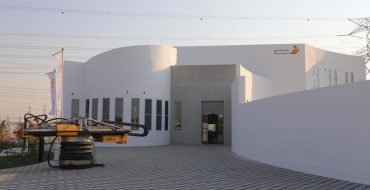
The world’s largest 3D-printed building, as verified by the Guinness Book of World Records, was just completed in Dubai. It offers 640 square meters of space and its two stories make the structure 9.5 meters tall. The building, dubbed the “Warsan building,” was created by Apis Cor, the same company that 3D printed a house for a mere $10,000 two years ago in Moscow.
Entire walls were 3D printed using the company’s uniquely designed 3D printer. The building’s foundation, insulation, roof and windows were installed conventionally, however.
The building was created on site using a special 3D printer designed by Apis Cor. The company conducted extensive research and development to test its gypsum-based material that is used for the structure’s walls.
The 3D printing process layers fluid along a path like an inkjet printer. The fluid is mineral infused and solidifies into concrete almost instantly.
The company hopes the process it has devised will be useful for affordable housing and is collaborating with a Santa Barbara nonprofit, the Housing Trust Fund of Santa Barbara County. 3D-printed construction may also one day aid space travelers who settle on other planets. Apis Cor is looking to test the feasibility of the process by building a demo home in the U.S. and is hoping to get sponsors.
Nikita Cheniuntai, the CEO and founder of Apis Cor, hopes that the collaboration with the Housing Trust can help pave the way for wider adaptation of this technology.
“The big challenge today is to make a technology that complies with all construction requirements. Our idea is to match 3D-printed walls with existing building standards by mimicking the concrete masonry unit (CMU) wall. We believe that it might be one of the possible ways to obtain building permits for 3D-printed homes,” he stated.
Dubai to Become the 3D Printing Hub of the World
Meanwhile, Dubai has proclaimed that around 25 percent of its buildings will be 3D printed by the year 2030, making the city a world leader in 3D printing—not just in construction but also in consumer and medical products. The city “aims to reduce labor by 70%, reduce cost by 90%, and reduce time by 80% in the different sectors,” according to government forecasting.
Dubai’s strategy was born in 2016, when the city saw massive growth in the technology-based construction sector expected to reach AED 2.2 billion (USD$600 million) by the year 2025. A 2018 McKinsey report, “The Future of Jobs in the Middle East,” expressed that the construction sector in Dubai was ripe for disruptive technologies and automation. With initiatives such as government-backed investment and infrastructure projects, the city has already been named “one of the most innovative and least wasteful” cities in the world. Soon after launching the strategy, the city unveiled its “Office of the Future”—a fully functioning 3D-printed office that has been inhabited since 2016.
Later, in May 2017, Dubai opened its first fully functioning fully 3D-printed office, which became the temporary home of the Dubai Future Foundation. According to reports by Reuters in 2016, the office was built in only 17 days and cost about $140,000. The arc-shaped building has given Dubai and its administrators the proof that their 3D printing strategy will be successful. Mohamed Al Gergawi, the United Arab Emirates Minister of Cabinet Affairs claims that “studies estimated the technique could cut building time by 50-70 percent and labor costs by 50-80 percent.”
New Projects and Research Around the World
3D printing may help make housing more affordable to those in need. At the end of 2019, Mexico created two 3D-printed homes through a partnership between New Story, a nonprofit focusing on homelessness; ICON, a construction technologies firm; and ÉCHALE, a Mexican nonprofit. The partnership plans to build a total of 50 homes for selected needy families in Tabasco, Mexico. Each 500-square-foot home takes 24 hours to build and has a living room, two bedrooms, a kitchen and a bath.
The Mexican partnership uses a Vulcan II printer, a gantry-style printer using a cementitious-based material that ICON has dubbed “Lavacrete,” and a combination of automation, mechatronics and specialized software.
In the summer of 2019, faculty from Penn State’s College of Engineering and the College of Arts and Architecture also created sustainable 3D-printable concrete structures. The researchers designed a sustainable concrete along with a new cement-based mixture that is primarily used for home building and small building construction. They also developed a 3Dprinter system consisting of a dual mixer and pump that feeds a nozzle manipulated by an industrial six-axis robotic arm.
This research has been carried out with an interdisciplinary approach—“material mixture, material characterization and design, and printing process and system.” The team hopes that the research will have an impact on the carbon dioxide emissions that conventional cement industry creates—about “5 percent of the total CO2 emissions.”
A new project with residential homes is being built this way by Emaar Development. Where is it? Dubai, of course.
https://www.engineering.com/BIM/ArticleID/19863/Worlds-Largest-3D-Printed-Building-in-Dubai.aspx